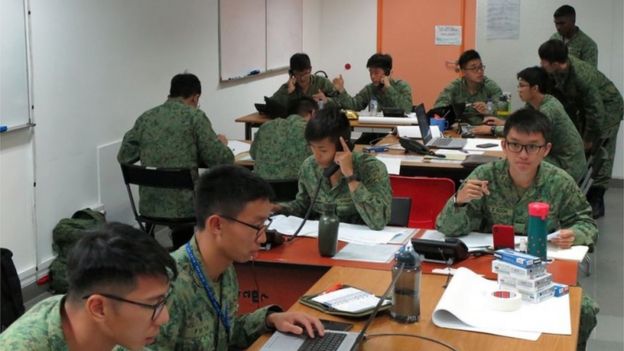Crisis Management East Asian Style
"It's not too late to implement some of these things. This is going to be going on for months ...There's always value from learning from others who've had success."
"I can say this because I'm [ethnic] Asian but they're generally pretty obedient people. I find that in a lot of Western countries there's this philosophy of individualism."
"Canadians are very nice and we assume that everybody will follow the rules ... [but] we might have been too lax."
Dr.Jeff Kwong, family physician, public-health professor, University of Toronto
"It's just hard for people watching Canadians not take things seriously, knowing that in Singapore they took it very seriously from the start and therefore have the outbreak under control."
Ben Beingessner, vice-principal, Singapore American School
"It's like crime-solving."
"More or less, it's similar kinds of skills required -- piecing information from different people and different places together."
Assistant police superintendent Johnny Lim, Singapore
"I haven't felt that I've been inconvenienced. Shops and restaurants are open ... I'm able to go outside, I'm able to live my life pretty much normally right now."
"I'm not kidding when I say that everywhere you go, your temperature is taken."
"I'm normally a very pessimistic person by nature. But, strangely at this time, I'm very positive. I feel safe here."
Sandra Johnson, 32, Canadian expat, Mississauga, Ontario, in Singapore
 |
The economy remains intact. Schools, businesses, stores and restaurants are all open for business despite some restrictions. The difference seems to be that both Taiwan and Singapore took immediate steps to strictly isolate those who were seen to have, or might have, COVID-19. International travel came under tight control. And health and security authorities diligently pursued people who had contact with the infected.
In Singapore, police officers were deployed to track down contacts with the use of cellphones keeping tabs on people in quarantine. Taiwanese citizens' recent international travel histories were merged with their digital health insurance files to enable doctors and pharmacists to have access. Stiff fines were levied for violations of quarantine. A recent journal paper published by three Singapore doctors commented "relative normalcy of day-to-day life has been maintained".
 |
| Commuters pack a metro train in downtownTaipei, Taiwan on March 18, 2020 in Taipei, Taiwan. |
The 4,000-student Singapore American School has taken steps to avoid crowding, but little else has changed in the operation of the school, pointed out Regina native Ben Beingessner. Like Toronto, both Singapore and Taiwan had undergone previous experience with the SARS outbreaks in 2003, planning to make certain they would not be as seriously impacted again by another infectious disease. Both carried out plans to prepare for the eventuality of another epidemic; it appears that Toronto failed to, to the full extent required.
Dr.Kwong from University of Toronto, sees some potential barriers to Canada adapting to a similar approach to those that the Asian countries chose, to control the epidemic; for one, chronic underfunding of public health in Canada, and in addition a population that feels unease with government control, unlike Asian populations. The obvious reality is that both Taiwan and Singapore have military-type governments to manage health care universally. Canada's federal system works with 13 separate health jurisdictions each delivering various responses to the pandemic.
"Just be alert and take early action to stop the spread of the virus", was the response by Jason Wang, a Stanford University professor with a paper recently published on Taiwan's COVID-19 success, who believes no real reason exists that Western nations cannot take similar action. "Whether the intensive nature of these policies can be maintained until the end of the epidemic and continue to be well received by the public is unclear", his paper concludes.
Taiwan set up a national health command centre shortly following SARS, including a central epidemic command centre. Extensive measures were taken to identify cases imported into the country as news of the new coronavirus emerged from Wuhan.Taiwanese officials boarded planes arriving from Wuhan to immediately assess passengers' health, ordering those with fever into isolation.
The government stockpiled supplies, recruited reserve soldiers to work on production lines for surgical and N95 masks, resulting in 44 million and 2 million of each respectively being available in quick order. The pricing was strictly controlled, to avoid profiteering and a rationing system allocating two masks per week to citizens was implemented.
 |
| The temperature screening station at a mall near Canadian Sandra Johnson’s home, part of Singapore’s extensive efforts to contain the COVID-19 virus. |
Quarantine violators were pursued; those who had disappeared instead of remaining in isolation, given fines of $3,000 each; names published of those who failed to go into quarantine as instructed; $130,000 fines threatened for the spreading of false news. Singapore had built a national centre for infectious disease -- a dedicated 330-bed facility -- after its experience with SARS. Health and temperature screening of passengers from Wuhan began on January 3, and by the end of the month COVID-19 tests were increased to 2,200 daily.

Police officers are tasked with tracking down contacts of infected people or identifying the source of an infection cluster. Harvard public health experts produced a recent paper estimating that Singapore finds three times as many infected people, compared to the rest of the world. Random phone calls requiring those in isolation at home to take photographs of their surroundings as verification that they are indeed at home, along with mandatory-response texts with GPS location information are routine.
Anywhere and everywhere people go throughout the course of their daily lives, they have become accustomed to random screening for fever; at malls, office buildings, community centres and places of worship. Everything seems to work like clockwork; well planned, detailed and carried out. And then the inevitable of new cases surfacing -- imported from outside both countries.
 |
| Singapore has even deployed the armed forces in contact-tracing Reuters |
Labels: Canada, Crisis Management, Novel Coronavirus, Singapore, Taiwan

<< Home